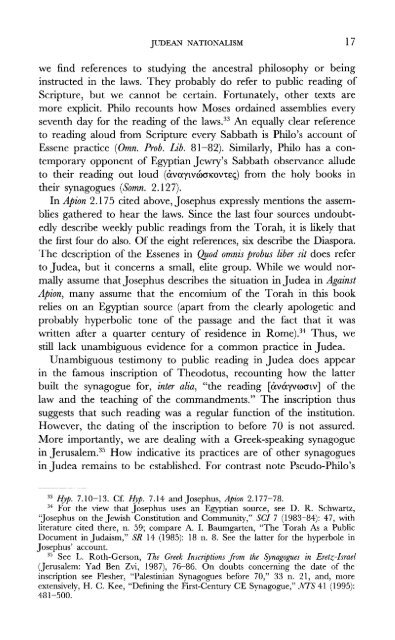historical perspectives: from the hasmoneans to bar kokhba in light ...
historical perspectives: from the hasmoneans to bar kokhba in light ...
historical perspectives: from the hasmoneans to bar kokhba in light ...
You also want an ePaper? Increase the reach of your titles
YUMPU automatically turns print PDFs into web optimized ePapers that Google loves.
JUDEAN NATIONALISM 17<br />
we f<strong>in</strong>d references <strong>to</strong> study<strong>in</strong>g <strong>the</strong> ancestral philosophy or be<strong>in</strong>g<br />
<strong>in</strong>structed <strong>in</strong> <strong>the</strong> laws. They probably do refer <strong>to</strong> public read<strong>in</strong>g of<br />
Scripture, but we cannot be certa<strong>in</strong>. Fortunately, o<strong>the</strong>r texts are<br />
more explicit. Philo recounts how Moses orda<strong>in</strong>ed assemblies every<br />
seventh day for <strong>the</strong> read<strong>in</strong>g of <strong>the</strong> laws. 33 An equally clear reference<br />
<strong>to</strong> read<strong>in</strong>g aloud <strong>from</strong> Scripture every Sabbath is Philo's account of<br />
Essene practice (Omn. Prob. Lib. 81—82). Similarly, Philo has a contemporary<br />
opponent of Egyptian Jewry's Sabbath observance allude<br />
<strong>to</strong> <strong>the</strong>ir read<strong>in</strong>g out loud ( ) <strong>from</strong> <strong>the</strong> holy books <strong>in</strong><br />
<strong>the</strong>ir synagogues (Somn. 2.127).<br />
In Apion 2.175 cited above, Josephus expressly mentions <strong>the</strong> assemblies<br />
ga<strong>the</strong>red <strong>to</strong> hear <strong>the</strong> laws. S<strong>in</strong>ce <strong>the</strong> last four sources undoubtedly<br />
describe weekly public read<strong>in</strong>gs <strong>from</strong> <strong>the</strong> Torah, it is likely that<br />
<strong>the</strong> first four do also. Of <strong>the</strong> eight references, six describe <strong>the</strong> Diaspora.<br />
The description of <strong>the</strong> Essenes <strong>in</strong> Quod omnis probus liber sit does refer<br />
<strong>to</strong> Judea, but it concerns a small, elite group. While we would normally<br />
assume that Josephus describes <strong>the</strong> situation <strong>in</strong> Judea <strong>in</strong> Aga<strong>in</strong>st<br />
Apion, many assume that <strong>the</strong> encomium of <strong>the</strong> Torah <strong>in</strong> this book<br />
relies on an Egyptian source (apart <strong>from</strong> <strong>the</strong> clearly apologetic and<br />
probably hyperbolic <strong>to</strong>ne of <strong>the</strong> passage and <strong>the</strong> fact that it was<br />
written after a quarter century of residence <strong>in</strong> Rome). 34 Thus, we<br />
still lack unambiguous evidence for a common practice <strong>in</strong> Judea.<br />
Unambiguous testimony <strong>to</strong> public read<strong>in</strong>g <strong>in</strong> Judea does appear<br />
<strong>in</strong> <strong>the</strong> famous <strong>in</strong>scription of Theodotus, recount<strong>in</strong>g how <strong>the</strong> latter<br />
built <strong>the</strong> synagogue for, <strong>in</strong>ter alia, "<strong>the</strong> read<strong>in</strong>g [ ] of <strong>the</strong><br />
law and <strong>the</strong> teach<strong>in</strong>g of <strong>the</strong> commandments." The <strong>in</strong>scription thus<br />
suggests that such read<strong>in</strong>g was a regular function of <strong>the</strong> <strong>in</strong>stitution.<br />
However, <strong>the</strong> dat<strong>in</strong>g of <strong>the</strong> <strong>in</strong>scription <strong>to</strong> before 70 is not assured.<br />
More importantly, we are deal<strong>in</strong>g with a Greek-speak<strong>in</strong>g synagogue<br />
<strong>in</strong> Jerusalem. 35 How <strong>in</strong>dicative its practices are of o<strong>the</strong>r synagogues<br />
<strong>in</strong> Judea rema<strong>in</strong>s <strong>to</strong> be established. For contrast note Pseudo-Philo's<br />
33 Hyp. 7.10-13. Cf. Hyp. 7.14 and Josephus, Apion 2.177-78.<br />
34 For <strong>the</strong> view that Josephus uses an Egyptian source, see D. R. Schwartz,<br />
"Josephus on <strong>the</strong> Jewish Constitution and Community," SCI 7 (1983-84): 47, with<br />
literature cited <strong>the</strong>re, n. 59; compare A. I. Baumgarten, "The Torah As a Public<br />
Document <strong>in</strong> Judaism," SR 14 (1985): 18 n. 8. See <strong>the</strong> latter for <strong>the</strong> hyperbole <strong>in</strong><br />
Josephus' account.<br />
35 See L. Roth-Gerson, The Greek Inscriptions <strong>from</strong> <strong>the</strong> Synagogues <strong>in</strong> Eretz-Israel<br />
(Jerusalem: Yad Ben Zvi, 1987), 76—86. On doubts concern<strong>in</strong>g <strong>the</strong> date of <strong>the</strong><br />
<strong>in</strong>scription see Flesher, "Palest<strong>in</strong>ian Synagogues before 70," 33 n. 21, and, more<br />
extensively, H. C. Kee, "Def<strong>in</strong><strong>in</strong>g <strong>the</strong> First-Century CE Synagogue," NTS 41 (1995):<br />
481-500.

















